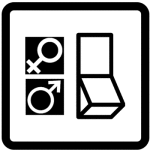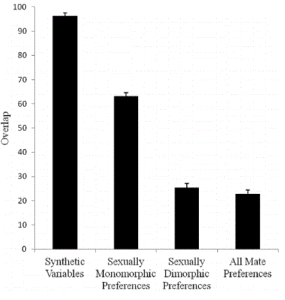I recently posted about psychologist David Schmitt discussing the poorly

wrought criticism against research in sex differences for mate preference. Coincidentally, yesterday the University of Texas at Austin news reported a new analysis of sex differences, How sexually dimorphic are human mate preferences? was published.
This is far from the first study to report such differences, but its authors wrote that most existing work uses univariate statistics, that is, analysis of one trait at a time, whereas multivariate statistics are more appropriate because “mate selection is inherently multidimensional.” Here is my summary & the hard numbers.
Cite
Conroy-Beam, D., Buss, D. M., Pham, M. N., & Shackelford, T. K. 2015. How Sexually Dimorphic Are Human Mate Preferences?. Personality and Social Psychology Bulletin, 0146167215590987. Link.
Authors
Daniel Conroy-Beam, David Buss, Michael Pham, Todd Shackelford.
N = 10, 153 (4,764 men, 5,389 women)
Cultures: 37
Countries: 33
Nigeria, South Africa (whites, Zulu), Zambia, China, India, Indonesia, Israel (Jewish, Palestinian), Japan, Taiwan, Bulgaria, Estonian S.S.R., Poland, Yugoslavia, Belgium, France, Finland, Germany, Great Britain, Greece, Ireland, Italy, Netherlands, Norway, Spain, Sweden, Canada (French, English), USA (mainland, Hawaii), Australia, New Zealand, Brazil, Colombia, Venezuela.
Data
20 variables :
Good looks
Desires a home and child
Refined
Dependable
Health
Ambition
Mutual attraction
Chastity
Emotionally stable
Similar political views
Status
Similar religion
Good cook
Pleasing disposition
Education
Similar education
Age difference
Sex
Except for age and sex, participants indicated the desirability of the characteristic on a 4-point scale where 0 = irrelevant or unimportant and 3 = indispensable. The age variable is the difference between a mate’s ideal age and the participant’s age.
Findings
Overall overlap between the sexes: 22.8%
Accuracy of predicting sex based on preferences alone: 92.2%
Overall D = 2.41
(Mahalanobis distance, the number of standard deviations between a point and the mean of a distribution)
Five variables for which no evolutionary sex difference was predicted in fact did not predict sex: pleasing disposition, sociability, similar religion, similar political views, and mutual attraction.
Cross-Cultural Differences
Individual trait and overall sex differences in preferences declined with measures of increased gender empowerment. However, a wide difference remained strong and was predicted to be so (D = 1.8) even at a theoretical point of perfect gender equality.
The overall difference in mate preference was three times higher than the variability of that difference across cultures.
Criticism
The data for this analysis are from 1989. Global changes between then and now could effect the outcome, though that seems unlikely under the circumstances. That is, it is unlikely that people of Nigeria, Ireland, and Colombia (for example) just happened to be similar in a particular year but not others.
Small scale societies are not represented.
Political corollary
Men and women are different in some important ways, and not because of society. This is a truth now supported by overwhelming evidence. One may choose to believe the contrary, and that is their right, but not without making themselves indistinct from deniers of anthropogenic climate change or the safety of routine vaccinations. When you blithely call 95% of the experts wrong, you are a science denialist.
This sort of paper ought cause no hand-wringing and prompt no fear, though. If we want people to be happy and free, we have to have good information about what people are like, so that we don’t inadvertently obstruct their flourishing. This paper is to do with aspects of the majority of people, not all, just most. We now know that we can’t socially program away the impulse in them to be feminine or masculine, and it harms them to try. They should be permitted the freedom and personal autonomy to be who they are.
And those who are not near to “average” or what “most people” are like? They should enjoy precisely the same freedom. Many strong voices argued, quite effectively, that marriage equality was important because everyone deserves the same freedoms; Not because there’s literally no difference between gay people and straight people. Similarly, being not-the-norm has absolutely nothing to do with what freedoms or respect a person deserves as a sexual being. We do not need to imagine the genders are identical in order to believe their claim to human dignity is identical. It surely is, no matter the p values and d values.
See Also
The gender binary is not the problem
Evolved sex differences: David Schmitt skewers 10 spurious objections to evolutionary psychology
